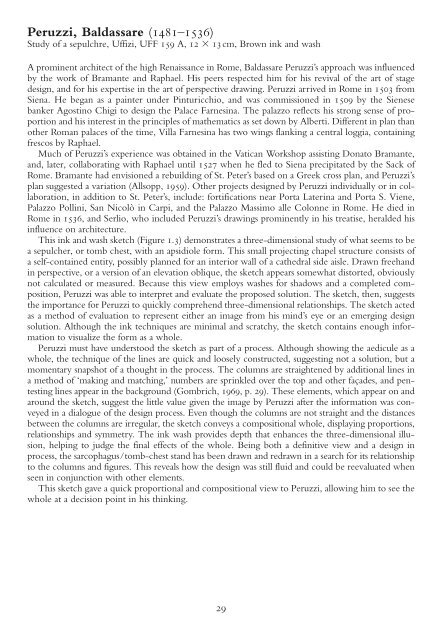Architect Drawings : A Selection of Sketches by World Famous Architects Through History
You also want an ePaper? Increase the reach of your titles
YUMPU automatically turns print PDFs into web optimized ePapers that Google loves.
Peruzzi, Baldassare (1481–1536)<br />
Study <strong>of</strong> a sepulchre, Uffizi, UFF 159 A, 12 13cm, Brown ink and wash<br />
A prominent architect <strong>of</strong> the high Renaissance in Rome, Baldassare Peruzzi’s approach was influenced<br />
<strong>by</strong> the work <strong>of</strong> Bramante and Raphael. His peers respected him for his revival <strong>of</strong> the art <strong>of</strong> stage<br />
design, and for his expertise in the art <strong>of</strong> perspective drawing. Peruzzi arrived in Rome in 1503 from<br />
Siena. He began as a painter under Pinturicchio, and was commissioned in 1509 <strong>by</strong> the Sienese<br />
banker Agostino Chigi to design the Palace Farnesina. The palazzo reflects his strong sense <strong>of</strong> proportion<br />
and his interest in the principles <strong>of</strong> mathematics as set down <strong>by</strong> Alberti. Different in plan than<br />
other Roman palaces <strong>of</strong> the time, Villa Farnesina has two wings flanking a central loggia, containing<br />
frescos <strong>by</strong> Raphael.<br />
Much <strong>of</strong> Peruzzi’s experience was obtained in the Vatican Workshop assisting Donato Bramante,<br />
and, later, collaborating with Raphael until 1527 when he fled to Siena precipitated <strong>by</strong> the Sack <strong>of</strong><br />
Rome. Bramante had envisioned a rebuilding <strong>of</strong> St. Peter’s based on a Greek cross plan, and Peruzzi’s<br />
plan suggested a variation (Allsopp, 1959). Other projects designed <strong>by</strong> Peruzzi individually or in collaboration,<br />
in addition to St. Peter’s, include: fortifications near Porta Laterina and Porta S. Viene,<br />
Palazzo Pollini, San Nicolò in Carpi, and the Palazzo Massimo alle Colonne in Rome. He died in<br />
Rome in 1536, and Serlio, who included Peruzzi’s drawings prominently in his treatise, heralded his<br />
influence on architecture.<br />
This ink and wash sketch (Figure 1.3) demonstrates a three-dimensional study <strong>of</strong> what seems to be<br />
a sepulcher, or tomb chest, with an apsidiole form. This small projecting chapel structure consists <strong>of</strong><br />
a self-contained entity, possibly planned for an interior wall <strong>of</strong> a cathedral side aisle. Drawn freehand<br />
in perspective, or a version <strong>of</strong> an elevation oblique, the sketch appears somewhat distorted, obviously<br />
not calculated or measured. Because this view employs washes for shadows and a completed composition,<br />
Peruzzi was able to interpret and evaluate the proposed solution. The sketch, then, suggests<br />
the importance for Peruzzi to quickly comprehend three-dimensional relationships. The sketch acted<br />
as a method <strong>of</strong> evaluation to represent either an image from his mind’s eye or an emerging design<br />
solution. Although the ink techniques are minimal and scratchy, the sketch contains enough information<br />
to visualize the form as a whole.<br />
Peruzzi must have understood the sketch as part <strong>of</strong> a process. Although showing the aedicule as a<br />
whole, the technique <strong>of</strong> the lines are quick and loosely constructed, suggesting not a solution, but a<br />
momentary snapshot <strong>of</strong> a thought in the process. The columns are straightened <strong>by</strong> additional lines in<br />
a method <strong>of</strong> ‘making and matching,’ numbers are sprinkled over the top and other façades, and pentesting<br />
lines appear in the background (Gombrich, 1969, p. 29). These elements, which appear on and<br />
around the sketch, suggest the little value given the image <strong>by</strong> Peruzzi after the information was conveyed<br />
in a dialogue <strong>of</strong> the design process. Even though the columns are not straight and the distances<br />
between the columns are irregular, the sketch conveys a compositional whole, displaying proportions,<br />
relationships and symmetry. The ink wash provides depth that enhances the three-dimensional illusion,<br />
helping to judge the final effects <strong>of</strong> the whole. Being both a definitive view and a design in<br />
process, the sarcophagus/tomb-chest stand has been drawn and redrawn in a search for its relationship<br />
to the columns and figures. This reveals how the design was still fluid and could be reevaluated when<br />
seen in conjunction with other elements.<br />
This sketch gave a quick proportional and compositional view to Peruzzi, allowing him to see the<br />
whole at a decision point in his thinking.<br />
29




